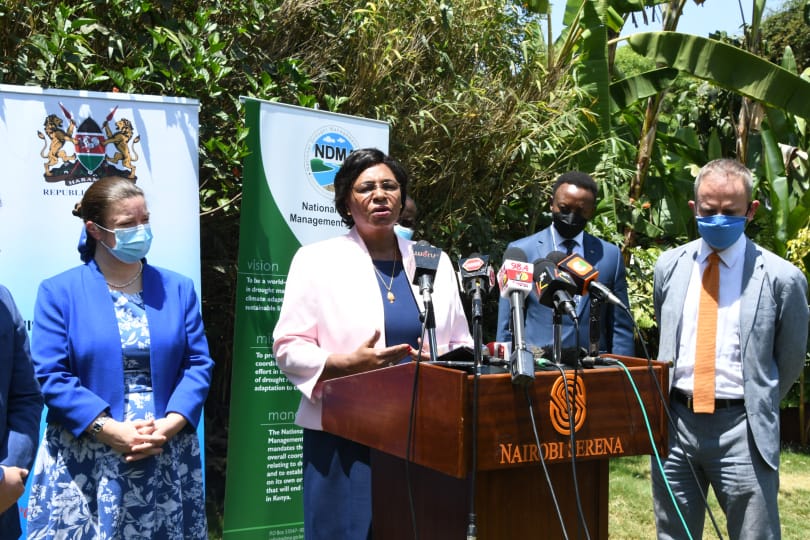The Government has disbursed Sh1.2 billion for purchase and distribution of food in 23 Arid and Semi-Arid Lands (ASAL) counties to benefit 2.5 million people who are hard hit by drought.
The Cabinet Secretary for Public Service, Gender, Senior Citizens Affairs and Special Programmes, Prof Margaret Kobia, said the government has also disbursed another Sh450 million to Kenya Defence Forces for livestock off-take, purchase and distribution of livestock feed.
Briefing the media at a Nairobi hotel after holding a consultative meeting with development partners in Arid and Semi-Arid Lands in the ASAL sector working group in Kenya, Prof Kobia said to respond to the National Disaster, the Multi-Agency Government Response Mechanism team has put in place measures to ensure that citizens of the affected counties are urgently supplied with food and other commodities to sustain their livelihoods.
To adequately address the impending crisis, Prof Kobia said the government has identified priority needs in key sectors amounting to Sh7.3 billion to cover the costs of delivering food and safety needs, livestock, health and nutrition, agriculture, education and water for the period ending December 2021.
“As government, we are committed to ensure that all steps are taken to address the drought crisis in the country. I wish to thank all stakeholders, including our development partners, for continuing to partner with the government to attend to this national disaster,” said the CS.
She also announced that Sh350 million has been allocated to the Ministry of Water and Sanitation for water trucking while Sh500 million has been allocated to National Drought Management Authority (NDMA), through the European Union, for drought emergency response in non-food interventions.
The Government is in the process of providing a second round of resources for interventions between November and December 2021, as the Sh1.2 billion was disbursed in October 2021.
Prof Kobia added that currently, eight counties are in the ‘alarm’ drought phase including Garissa, Isiolo, Lamu, Mandera, Marsabit, Tana River, Turkana and Wajir, where the outlook for the 2021 short rains is worrying with a further 12 counties being on the brink of sliding from ‘alert’ to ‘alarm’ phase.
The CS said the government is shifting from the distribution of physical food to cash transfer strategies in the fight against the negative impacts of drought in the country to increase efficiency and accountability.
“I wish to assure the country that the government will continue streamlining its disbursements under the social protection interventions through regular cash transfers every two months with the cash transfers targeting 369,000 vulnerable households and 734,119 vulnerable individuals,” she added.
Prof Kobia assured the country, that the government is focused and firmly on the right trajectory towards winning the war against the negative impacts of drought.
The United Nations Resident Coordinator in Kenya, Dr Stephen Jackson, during the briefing, said United Nations Children’s Fund (UNICEF) in collaboration with Agricultural organizations are targeting to assist over 800,000 people with food during this period of drought.
“We are going to offer 50 percent which is equivalent to 34 million US Dollars to fight against drought in Kenya,” he said.
On September 8, 2021, President Uhuru Kenyatta declared the drought affecting parts of the country a National Disaster and instructed the National Treasury and the Ministry of Interior and Coordination of National Government to spearhead government efforts to assist affected households including water and relief food distribution as well as livestock uptake.
Meanwhile, livestock keepers in Garissa are leaving their homes with their emaciated animals in the wake of dwindling pasture as drought ravages the area.
The nomads from the three counties of Ijara, Hulugho and Bothai have been forced to leave their weak and older animals along the road while they salvage the calves as they wander in search of water too.
Mr Ali Omar, 89, accompanied by Chairman of the defunct Ijara County Council, Mr Mohamed Gure, and Ijara Youth Leader, Mr Abdullahi Abdi, said the situation is worsening and pastoralists have left with their livestock from across the border towards River Tana which is 200 km away.
They said the richer livestock owners hired water bowsers to give water to the livestock and bought feeds from Nairobi and Mombasa while the poor livestock owners watch as their cattle died without water and pasture.
The trio called upon Garissa County Senator, Abdul Haji, Garissa County Governor, Ali Buno Korane, and Ijara MP, Sophia Abdi Noor, to try and salvage the little surviving livestock “even if it means digging into their personal pockets to assist the residents”.
They commended National Drought Management Authority (NDMA) and Kenya Red Cross, and Ministry of Interior and Co-ordination of National Government, for gathering data on the impact of drought in Ijara Constituency and Garissa County at large.
Ijara Deputy County Commissioner, Mr Willy Cheboi, said the government through Devolution Ministry, had donated 1000 bags of rice, 300 bags of beans and 50 cartons of cooking oil to residents in Masalani Town, Ijara Sub County.
By KNA Team





